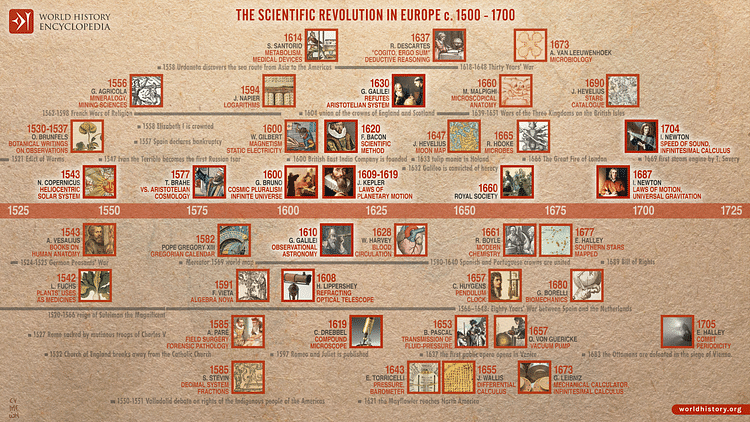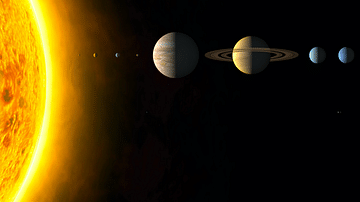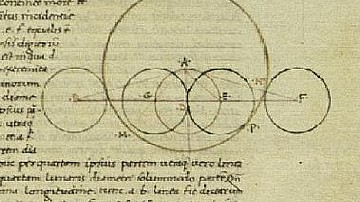
Johannes Kepler (1571-1630) was a German astronomer and mathematician most famous for creating what was up to that point the most accurate model of planetary astronomy with his three laws of planetary motion. Kepler was the first to present a coherent theory that the planets move around the Sun in elliptical orbits, that the speed of each planet varies, and that the Sun is responsible for that variation.
Early Life
Johannes Kepler was born on 27 December 1571 in Weil der Stadt in Baden-Württemberg, Germany. His father, Heinrich Kepler, was a soldier, and his mother was Katharina Guldenmann, daughter of a local mayor. Despite his humble background, Johannes was able to study at the University of Tübingen in Germany. Later in life, Kepler once said that his love of astronomy had begun at the age of six when his mother had taken him to a hill to observe a comet in the sky. An influential teacher at Tübingen was Michael Maestlin (1550-1631), an astronomer who adhered to the principles expounded by Nicolas Copernicus (1473-1543), the Polish astronomer who famously proposed that the Earth and other planets revolved around the Sun and not vice-versa. Kepler, too, accepted Copernicus' theory, despite the fact that he held an ambition to join the priesthood – the Christian view at that time being that the Earth was the centre of the universe.
Kepler was an unorthodox Lutheran, but most of his career was conducted at the courts of Catholic princes since they were eager to increase their own prestige by employing men of science. This meant that Kepler had to be careful concerning his scientific theories which challenged the standard Catholic worldview. Kepler was appointed the official instructor in astronomy and mathematics at the University of Graz in Austria in 1594, but he used most of his time for his own research. In 1597, Kepler published his Mysterium Cosmographicum (The Cosmographical Mystery). Here Kepler endorsed Copernicus' views and set out his "theory of the relation of the spacing of the planets to the geometrical ratios of the regular solids. (Regular solids are those whose faces and angles are equal and parallel: the tetrahedron, the cube, the octahedron, the dodecahedron, and the icosahedron)" (Burns, 158). Another name for the regular solids is the Platonic solids.
Kepler's Astronomical Theories
Kepler married a rich widow, Barbara Müller in 1597. The couple left Graz in 1598 for Prague as Kepler had been invited to the Bohemian capital by the Dane Tycho Brahe (1546-1601), who was the mathematician and astronomer at the court of Rudolf II, Holy Roman Emperor (r. 1576-1612). Kepler succeeded Tycho Brahe in 1601 and, crucially, inherited his extensive and accurate observations of planetary motion. Rudolf II was, then, an important patron of science. In 1627, Kepler dedicated his Rudolphine Tables to the emperor, which was a collection of stellar tables that permitted an astronomer to know any planet's past, present, and future position. The Tables was also an invaluable aid to navigators since there were some very useful extras such as a map of the world and a comprehensive list of the constellations.

Kepler set about precisely mapping the orbits of the planets, starting with the most difficult: Mars. Kepler was convinced that the universe was well-ordered because it followed God's plans. These plans could be read by humanity, thought Kepler, because they were rational and based on the logic of mathematics and geometry. Kepler was a great believer in cosmic harmony, indeed he took this quite literally and believed there was a direct correlation between the Holy Trinity of Christianity and the stars, the Sun, and what we today call space. This mixing of science with a view of the divine was not new. It had been common from antiquity right up to the 17th century (and even beyond) for astronomers to be also astrologers, and Kepler was no different (although he was the last significant figure in astronomy to practice astrology). Kepler "was obsessed with numerical precision" (Burns, 160). For Kepler, there could be no doubt that God was the mathematician par excellence. But just because the universe was and can be explained mechanically did not mean for Kepler (and others) that there was no divine cause, as here he explains in his own words:
My aim is this, to show that the celestial machine is not like a divine creature, but like a clock (he who believes the clock to be animate assigns the glory of the artificer to the work), insofar as nearly all the diversity of motions are caused by a simple, magnetic and corporeal force, just as all the motions of a clock are caused by a most simple weight. I will also show how this physical account is to be brought under mathematics and geometry.
(Wootton, 485)
Kepler became convinced that it was the Sun that governed the orbits of the planets, somehow sending out a force that precisely controlled these observable orbits. In 1600, following his exposure to the theories presented in On the Magnet by William Gilbert, Kepler believed this mysterious power the Sun held over the other celestial bodies may be something like magnetism (but he did not say it was magnetism). The true answer, we now know, is gravity, but Kepler (who knew that the Sun did rotate) was, in any case, more concerned with the practical and mathematically measurable problem of predicting the orbits of the planets, the force behind them could be studied by himself or others later. Another key idea for Kepler, and here he differed from almost everyone before him, was that the orbits were not perfectly circular but elliptical. This idea went against the theory of perfection of the Creator, but Kepler could argue that it was the repeated constancy of the orbits, forever repeating themselves, that was perfection, not their direction through space.

Kepler's Laws of Planetary Motion
Kepler set forth his radical new theories in two works: Astronomia Nova (The New Astronomy, 1609) and De Harmonices Mundi (Harmonies of the World, 1619). In these two works, Kepler outlines what he considered three fundamental principles or statistical regularities (he did not use the word 'laws') that govern planetary motion and which became known as Kepler's laws of planetary motion (here summarised by W. E. Burns):
- Planets move around the Sun in ellipses, with the Sun at one focus.
- A line drawn between a planet and the Sun will always sweep the same area in the same amount of time. Therefore, planets accelerate as they approach the Sun and decelerate as they move away from it.
- The squares of the times the planets take to go around the Sun are proportional to the cubes of their average distances from the Sun. (160)
Kepler's choice of the word 'harmonies' for his book title was no accident, as the historians Fermi and Bernardini here summarise:
Kepler was profoundly mystical…He thought that the relations between the maximum and minimum speeds of each planet were harmonic in the musical sense and expressed by musical intervals. Thus, he said, planets played a music that only the angels could hear.
(61)
Few were convinced by Kepler's ideas initially, even the other great contemporary astronomer Galileo (the two men never met but did correspond by letter) was sceptical, but Kepler's model of planets making elliptical orbits around the Sun because of some force the star gives forth was indeed proved to be correct.
Kepler's mysticism might have helped him look for causes and explanations, but it did sometimes lead him down the wrong path. He was convinced, for example, that because there were at the time six observable planets then the number six must have a special meaning. Kepler came up with a theory of interlocking inside themselves the five possible Platonic solids which were themselves special as the only forms where each has exactly the same face on all sides. This, for Kepler, explained why there could be no seventh planet (today, of course, we know there are more than six planets in our solar system). Searching for a sort of divine motivation, Kepler also explained why the orbits of the planets were elliptical and not perfectly spherical since the differences meant each orbit created a different 'note' in his concept of planetary musical harmony.
Other Writings
Besides astronomy, Kepler tackled many other scientific problems such as how the human eye works. He presented his theory of light being focused by the lens onto the retina in his 1604 work Supplement to Witelo. Kepler also wrote several texts on astrology and a volume on the new star that was discovered in 1604 and which now bears his name. Kepler created a popular and lasting theory that stars were caused by the burning of celestial waste. He wrote a treatise, Dioptrics, on the best optics for an astronomical telescope in 1611. The device had been invented a few years earlier and then perfected by Galileo, but Kepler's own innovation of using two convex lenses was crucial for the later history of the telescope and the Scientific Revolution. Kepler compiled a study of the volume of wine barrels (useful for his calculations on elliptical orbits), investigated the mystery of snowflakes (the first work of crystallography), pondered on how best to save space when stacking cannon balls (the Kepler conjecture), and even wrote a work of fiction, his Somnium, which is about a journey to the Moon but which was left unfinished at his death.
Death & Legacy
In 1612, Kepler left Prague for Linz in Austria, where he worked as a mathematician and teacher. He also made calendars for sale, and this work resulted in him realising that the traditional BC/AD chronology based on Jesus Christ's birth was four years out. Kepler was troubled in this period with defending his mother from charges of witchcraft. He was also having some financial difficulties since he had not been paid by Rudolf II for his services. In 1628 or 1629, Kepler moved on to work for Albrecht von Wallenstein (1583-1634), an important military commander and statesman for the Holy Roman Empire. Kepler's main task here was to create horoscopes. Johannes Kepler died of a fever at Regensburg while travelling back to Prague on 15 November 1630. He was buried in the Protestant cemetery of Saint Peter in Regensburg.
Kepler's accurate system of planetary astronomy was essential for later thinkers to build their work upon, most notably Isaac Newton (1642-1727). Newton provided the cause for Kepler's keen observations of planetary motions – gravity – in his Mathematical Principles of Natural Philosophy, published in 1687. Kepler's thoughts on a harmonious universe may not have held much sway with later scientists who investigated the cosmos as a series of neutral and unthinking mechanisms, but another lasting legacy is Kepler's use of the term 'satellite', which he first applied to the four moons of Jupiter discovered by Galileo.







